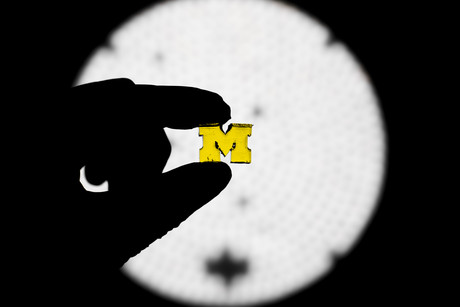Fast 3D printing with liquid resin

A new approach to 3D printing could run up to 100 times faster than conventional processes, according to research from the University of Michigan (U-M).
3D printing could be a game changer for relatively small manufacturing jobs (producing <10,000 identical items), because it would mean that the objects could be made without the need for a mould costing upwards of $10,000. But the most familiar form of 3D printing, which is sort of like building 3D objects with a series of 1D lines, hasn’t been able to fill that gap on typical production timescales of a week or two.
“Using conventional approaches, that’s not really attainable unless you have hundreds of machines,” said Timothy Scott, an associate professor at U-M.
Together with Professor Mark Burns, Assoc Prof Scott developed a 3D printing technique that involves lifting complex shapes from a vat of liquid resin. Two lights are used to control both where the resin hardens and where it stays fluid, enabling the team to solidify the resin in more sophisticated patterns. The result is that the researchers can make a 3D bas-relief in a single shot rather than in a series of 1D lines or 2D cross-sections, and have so far printed a lattice, a toy boat and a block M.
According to the team, this approach was necessary to overcome the limitations of earlier vat-printing efforts. Previously, resin tended to solidify on the window that the light shines through, stopping the print job just as it gets started.
An early solution to the solidification-on-window problem was a window that lets oxygen through. The oxygen penetrates into the resin and halts the solidification near the window, leaving a film of fluid that will allow the newly printed surface to be pulled away.
But because this gap is only about as thick as a piece of transparent tape, the resin must be very runny to flow fast enough into the tiny gap between the newly solidified object and the window as the part is pulled up. This has limited vat printing to small, customised products that will be treated relatively gently, such as dental devices and shoe insoles.
By replacing the oxygen with a second light to halt solidification, the U-M team can produce a much larger gap between the object and the window — millimetres thick — allowing resin to flow in thousands of times faster. This means that thicker resins — potentially with strengthening powder additives — can be used to produce more durable objects. The method also bests the structural integrity of filament 3D printing, as those objects have weak points at the interfaces between layers.
“You can get much tougher, much more wear-resistant materials,” Assoc Prof Scott said.
The researchers claim that the key to their success is the chemistry of the resin. In conventional systems there is only one reaction, with a photoactivator hardening the resin wherever light shines. In the U-M system, there is also a photoinhibitor, which responds to a different wavelength of light. Rather than merely controlling solidification in a 2D plane, as current vat-printing techniques do, the team can pattern the two kinds of light to harden the resin at essentially any 3D place near the illumination window.
“It’s one of the first true 3D printers ever made,” Prof Burns claimed.
U-M has filed three patent applications to protect multiple aspects of the approach, and Assoc Prof Scott is preparing to launch a start-up company. The work has been published in the journal Science Advances.
Please follow us and share on Twitter and Facebook. You can also subscribe for FREE to our weekly newsletter and bimonthly magazine.
Mechanical strain boosts lead-free ferroelectrics
Scientists have discovered a way to boost the performance of lead-free ferroelectrics using pure...
Crypto chip keeps water flowing in rural communities
Twisthink has integrated Microchip's ATECC608B crypto chip into an IoT pump sensor, to...
Engineers build longer-lasting qubit
Researchers have developed a superconducting qubit that operates for over one millisecond,...





